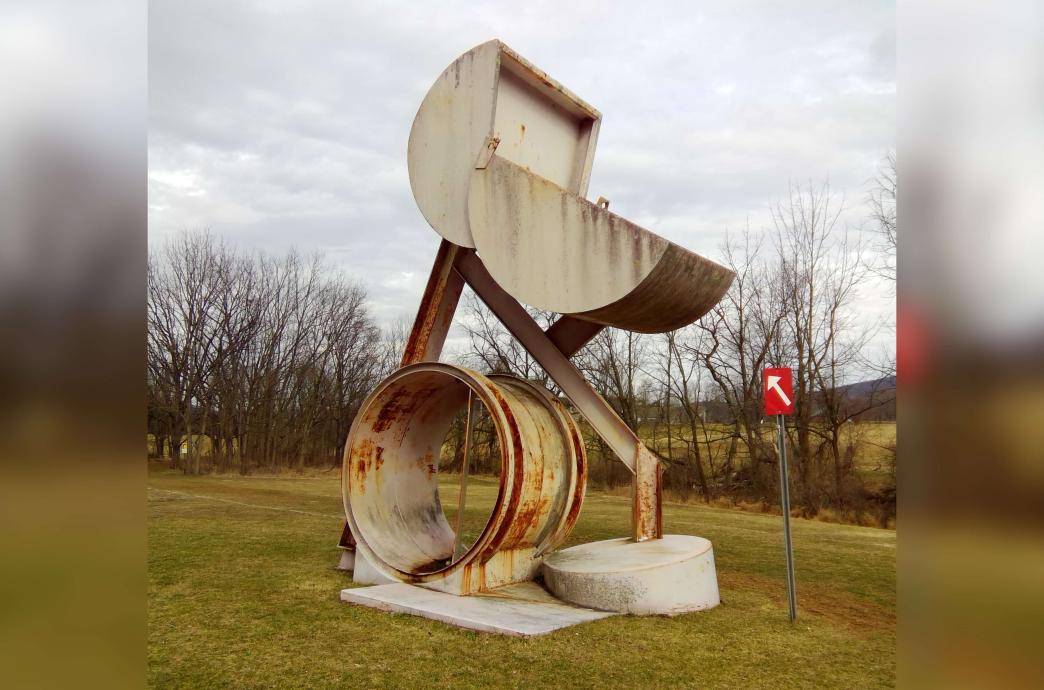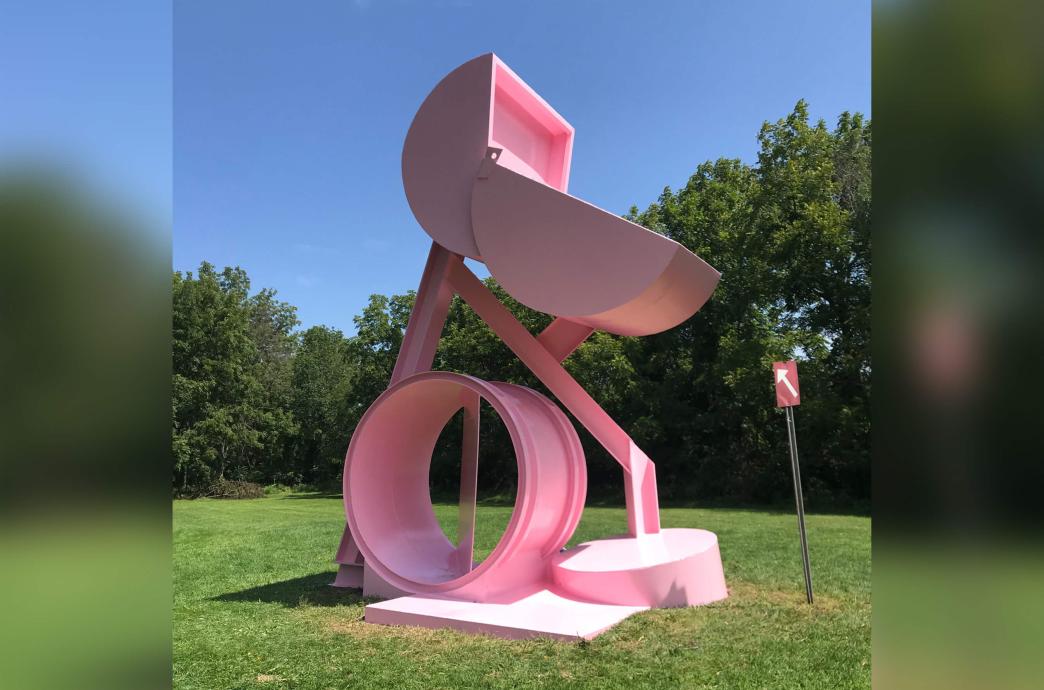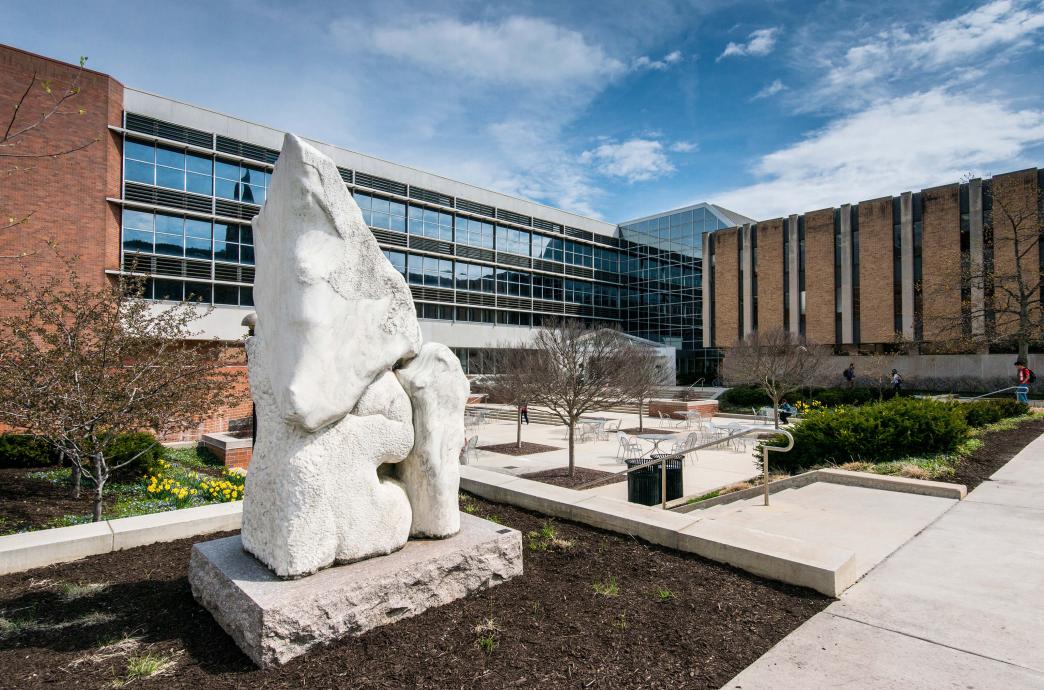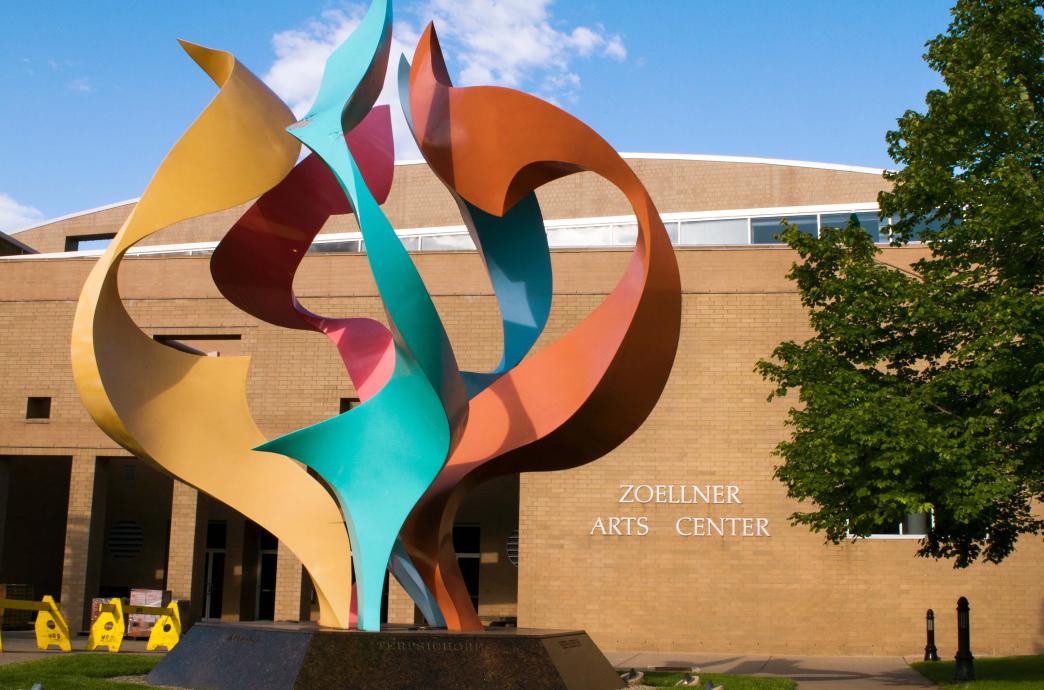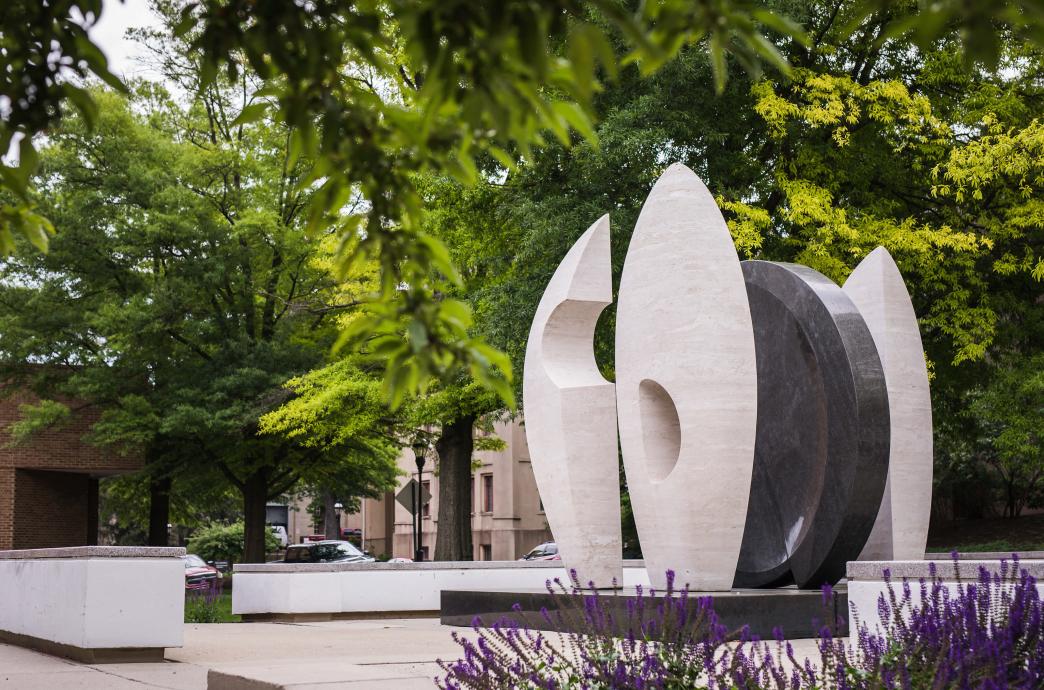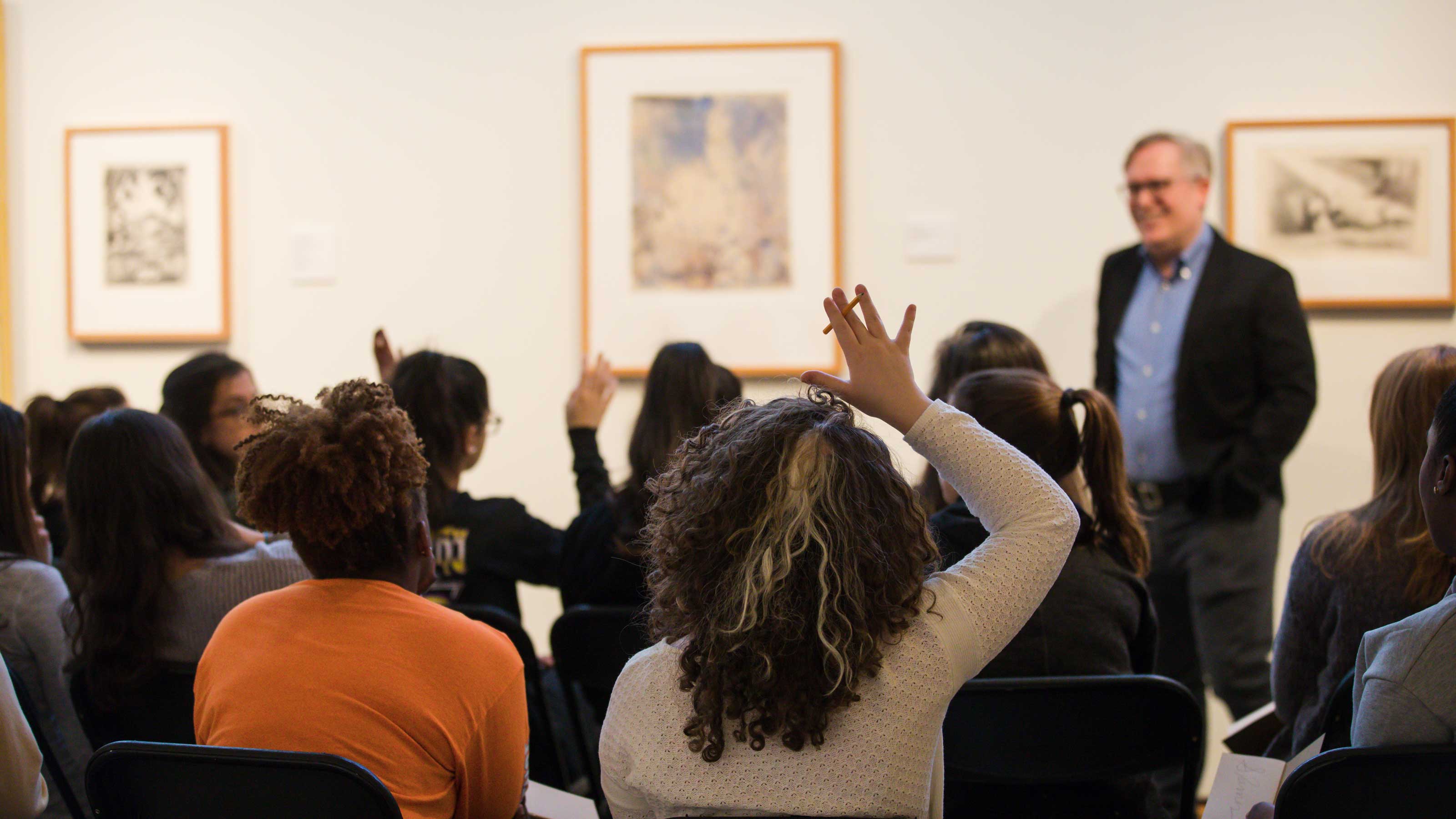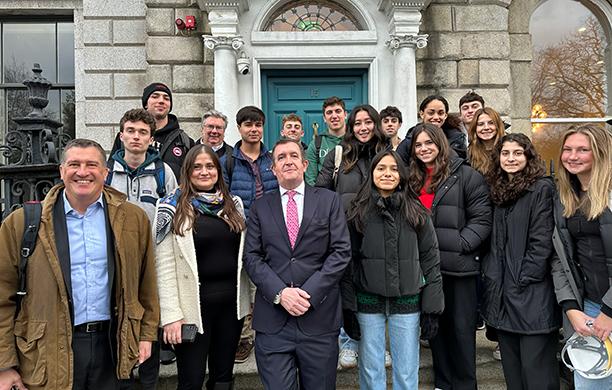First-time visitors strolling down Memorial Drive on Lehigh’s campus do a double take when they see her. What at first appears to be a real woman seated on one of the benches is in fact a sculpture so lifelike that passersby might be tempted to strike up a conversation.
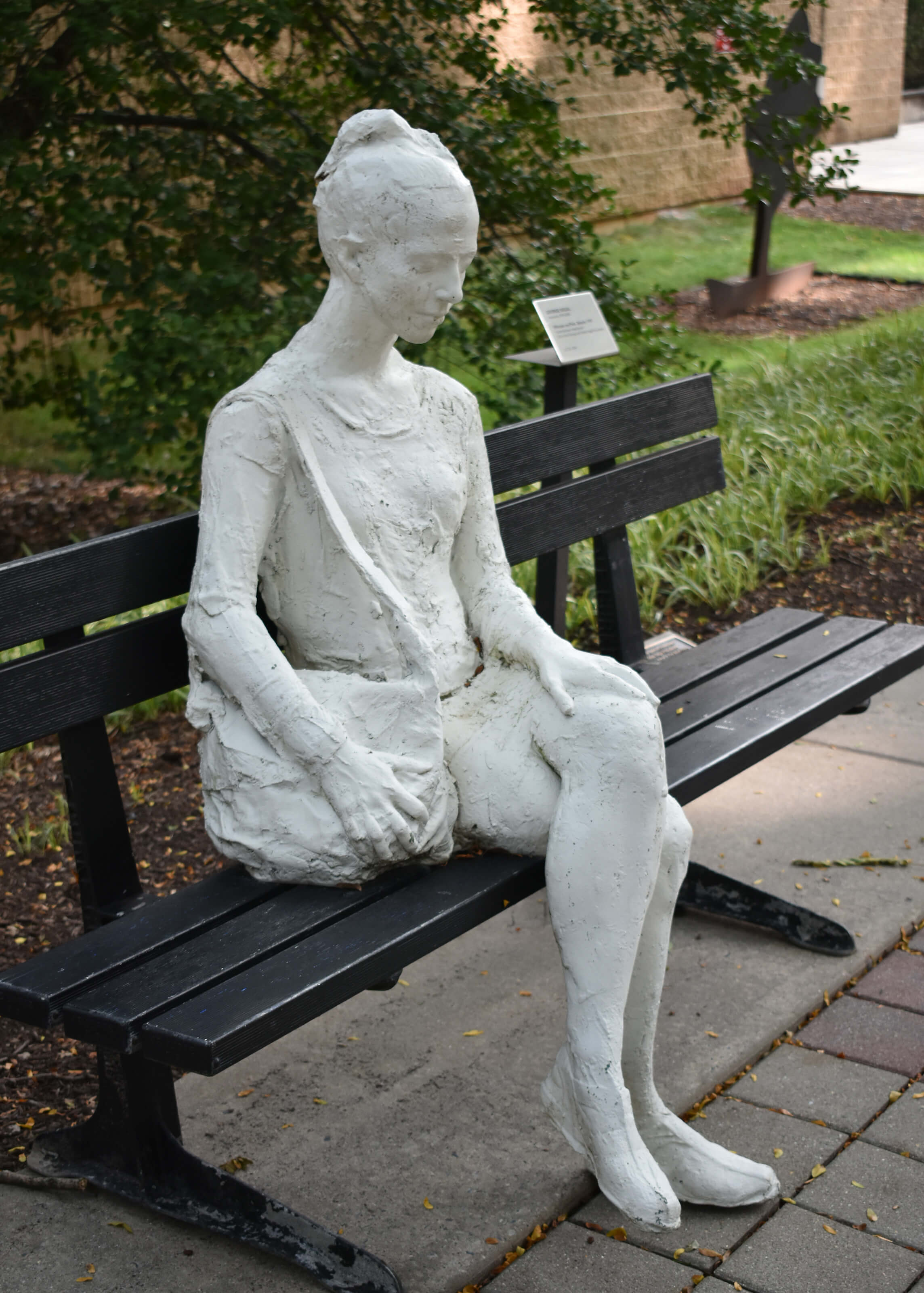
“Woman on Park Bench” by artist George Segal is one of nearly 60 outdoor sculptures on campus — all part of the Lehigh University Art Galleries’ permanent collection. Integrated into the landscape, the sculptures offer opportunities to interact with works of art at any time of day.
The Outdoor Sculpture Collection creates a campus that is uniquely Lehigh, helping it to be named to Research.com’s Top 50 Most Beautiful College Campuses in America. Maintaining the sculptures — which are exposed to wind, rain, snow, and other elements 365 days a year — is challenging. Costs can top more than $50,000 annually. Previously, with no dedicated budget for upkeep, expenses were covered by money from the College of Arts and Sciences or the university’s facilities department.
That changed in 2023 with the establishment of the LUAG Outdoor Sculpture Maintenance Endowment Fund. Seed money was provided by Jane P. Jamieson ’75 and Frederick H. Jamieson ’74 and by the Philip & Muriel Berman Foundation under the leadership of its director, Nancy Berman ’97H.
"The outdoor sculptures at Lehigh are a signature of our beautiful campus, inviting students and visitors alike to engage directly with works of art in their daily lives. However, they are also some of the most challenging works of art to maintain given their constant exposure to the elements,” says William Crow, director of Lehigh University Art Galleries. “We are deeply grateful to the donors who support this endowment that will help us care for this standout collection for future generations."
Establishing a permanent endowment for the fund was possible because of the collective support of alumni and friends of the university, each with an appreciation for the sculptures and the part they play in creating Lehigh’s landscape.
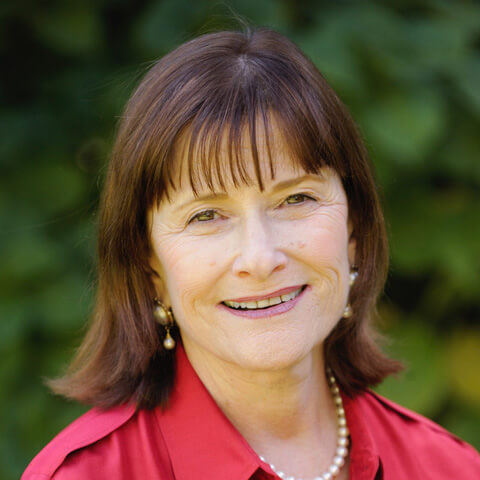
Continuing a Family Legacy
Berman says supporting Lehigh’s outdoor sculpture collection means building on a legacy started by her parents, Philip ’69H and Muriel Berman ’91H. The Bermans donated many of the outdoor sculptures familiar to generations of alumni.
“The reason my parents gave outdoor sculpture to Lehigh was because they believed that art was such an important part of life,” Berman says. “They thought that if art was introduced to college-age students in their everyday experiences — literally and figuratively placing sculptures in one’s path — it [would become] part of their consciousness and curiosity.”
Among those that she feels are “immediately accessible” to students are Segal’s “Woman on a Park Bench” and J. Seward Johnson’s “Between Classes,” the latter a lifelike figure of a male student, book in hand and red backpack at his feet. She also notes the dramatic placement of eight 20-foot-high sculptures of “Trees” made of corten steel, with cutouts revealing the presence of Lehigh’s own abundant landscape within the monumental piece by artist Menashe Kadishman.
Berman says that her father’s passion for large outdoor sculptures included encouraging artists to create them, and he would provide the necessary support. She recalls an innovative three-week workshop/residency in the Lehigh Valley that he organized, inviting sculptors who usually worked in stone to work in metal and metal workers to create in stone. He provided space, the raw materials, and the experts in stone cutting and metal fabricating to help them create monumental sculptures. Philip Berman then took responsibility for finding a permanent home for the works, many of which went to Pennsylvania colleges and universities. Lehigh was among the institutions receiving a lion’s share.
“Collecting art requires a commitment to preserving it, whether it is an oil painting in a gallery or outdoor sculpture on campus,” Berman states. “And ongoing maintenance prevents deterioration, which ameliorates the need for conservation in the long run. That’s why this endowment fund for this purpose is so essential.”
Berman, who lives in Los Angeles, also contributes her time as a member of the LUAG Advisory Council. Her previous service to Lehigh includes 11 years as a trustee, and she was also a member of the Academic Affairs Committee for seven years, the Cultural Affairs Committee for 11 years, the Executive Committee for three years, and the Advancement Committee for one year. Berman also was a corporate trustee from 2004-09 and has been a trustee emeritus since 2013.
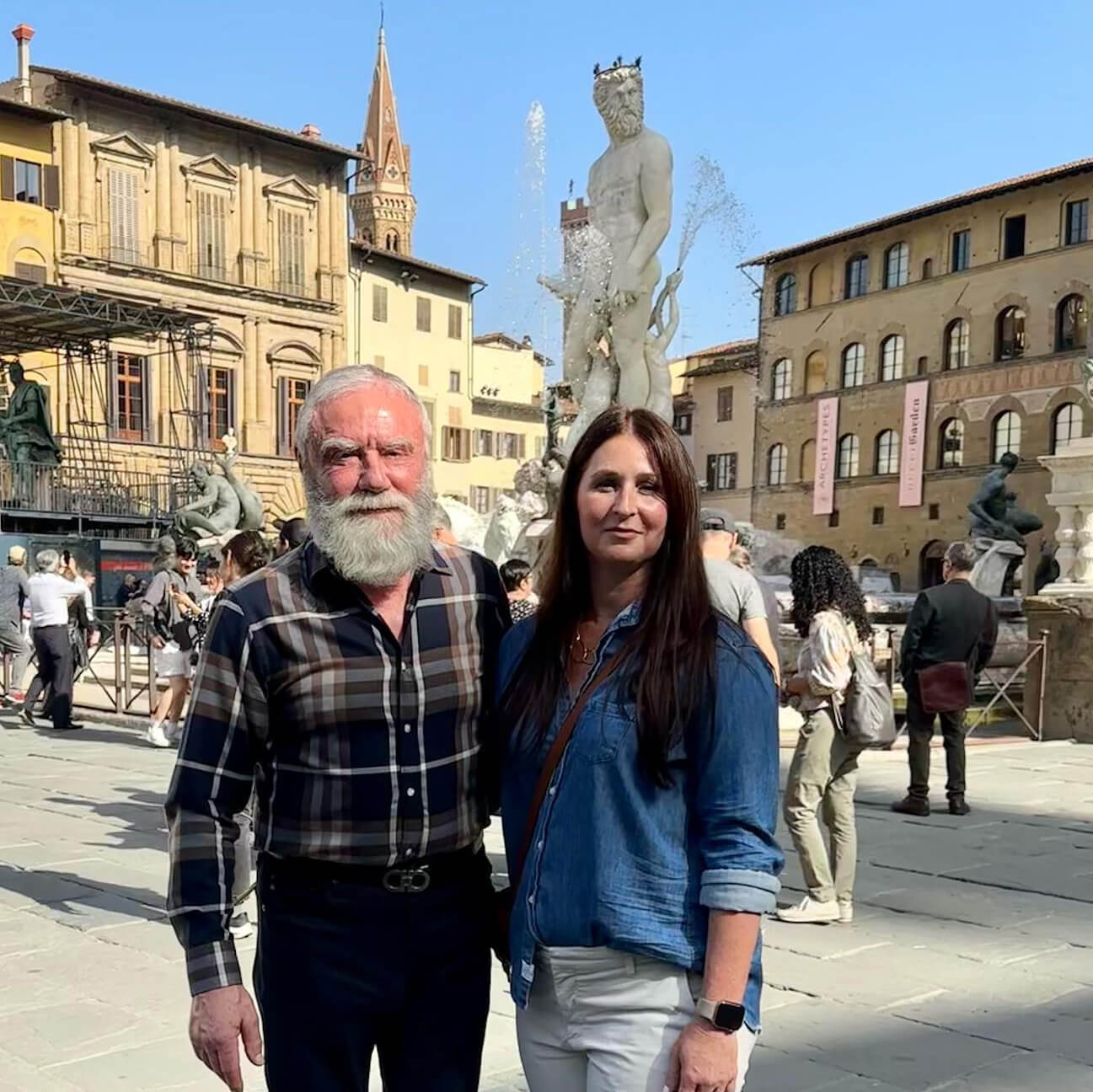
Fostering Creative Experiences
A commitment to art and fostering creativity are priorities for Amanda ’15G and Emilio DiIorio. Emilio, a surgeon and the former founder and CEO of Coordinated Health, now devotes himself to full-time work as a sculptor and author. Amanda leads Atelier Lucca, an artist management company representing Emilio’s work. Their long connection and support of Lehigh began when Emilio founded Lehigh’s sports medicine program, serving as team physician and providing care for the Mountain Hawks athletics teams for 20 years.
Now their involvement with the university centers on the LUAG Director’s Advisory Council. Their interest in supporting the Outdoor Sculpture Maintenance Endowment Fund stems from a belief in the value the sculptures bring to students’ educational experience.
“We support the galleries as a whole, but we have a specific interest in the outdoor sculptures. We think it's a unique part of the Lehigh campus,” Amanda says. “It's a way to connect the population of Lehigh closer to the arts. It meets students where they are at instead of physically going into the gallery. It's important that sculpture can be part of their day. Students who may not ever go in the gallery are still experiencing the art that Lehigh has to offer.”
The DiIorios, who reside in Bethlehem, PA, are especially enthusiastic about the way Crow has encouraged classes across majors and departments to visit the gallery and sculptures, tapping into them for class projects.
“Having the arts on campus really is a way to spur creativity across the board, regardless of degree field,” Emilio says.
Emilio, who has written a book manuscript on creativity and how to develop the inherent creativity within each of us, believes “that there are opportunities for each student to take a multi-disciplinary approach to developing their creativity. We can learn and practice throughout our lives. It's a muscle you can flex. It's not a matter of ‘I'm right brained or left brained’ or ‘I have it, or I don't have it.’ Creativity shows up regardless of where you're at.”
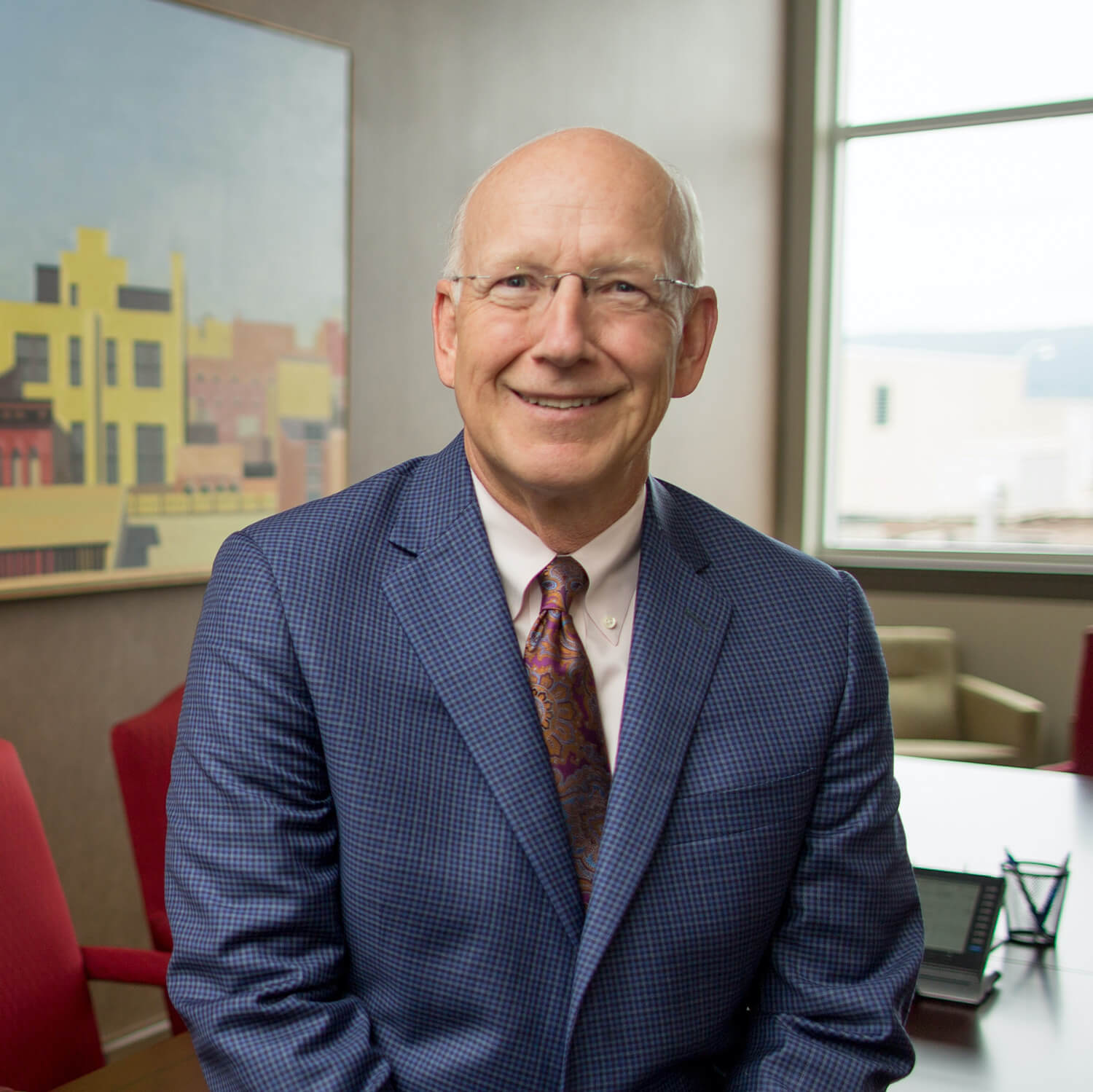
A Continuing Commitment
For Ollie Foucek ’72 ’05P ’09P, supporting the arts has been central to his involvement at Lehigh.
Foucek’s many years of volunteering at the university include time as class president, chair of the Senior Class Gift Committee, chair of the Annual Fund, young alumnus trustee, president of the Alumni Association, university trustee, member of the Cultural Affairs Subcommittee of the Board of Trustees, and member of the Dean’s Advisory Council for the College of Arts and Sciences.
For the last two decades, he has been actively involved with Zoellner Arts Center — the heart of visual and performing arts at Lehigh — including serving as chair of Friends of Zoellner. Foucek, a lawyer with the Allentown firm Norris McLaughlin, P.A., says it was a natural step to become a member of the LUAG Director’s Advisory Council. He traces his interest in the visual arts to the many museums he visited growing up near New York City and traveling through Europe as part of his father’s work in the airline industry.
The value of supporting the preservation of the university’s outdoor sculptures comes down to a simple question, Foucek says: “What helps to make our campus beautiful?” The sculptures play an integral role.
“You can’t walk from one academic building to another [on the Packer campus] without passing some wonderful piece of sculpture,” he says, adding that the bigger open spaces on the Goodman and Mountaintop campuses lend themselves to larger works. Drawing on his experience as a member and chair of Friends of Zoellner, which supports ongoing needs at the art center, Foucek recognizes that funding is necessary to maintain the sculptures.
His favorites include the Asa Packer statue outside the Alumni Memorial Building by Czech sculptor Karel Mikolas. “He is someone I’ve gotten to know and is a fascinating guy and a fantastic sculptor,” Foucek says. His other favorite is Allentown artist David Cerulli’s “A State of Rejuvenescence.” The vivid colors of the sculpture, which stands outside Zoellner, echo the colors in a painting by the artist that Foucek owns.
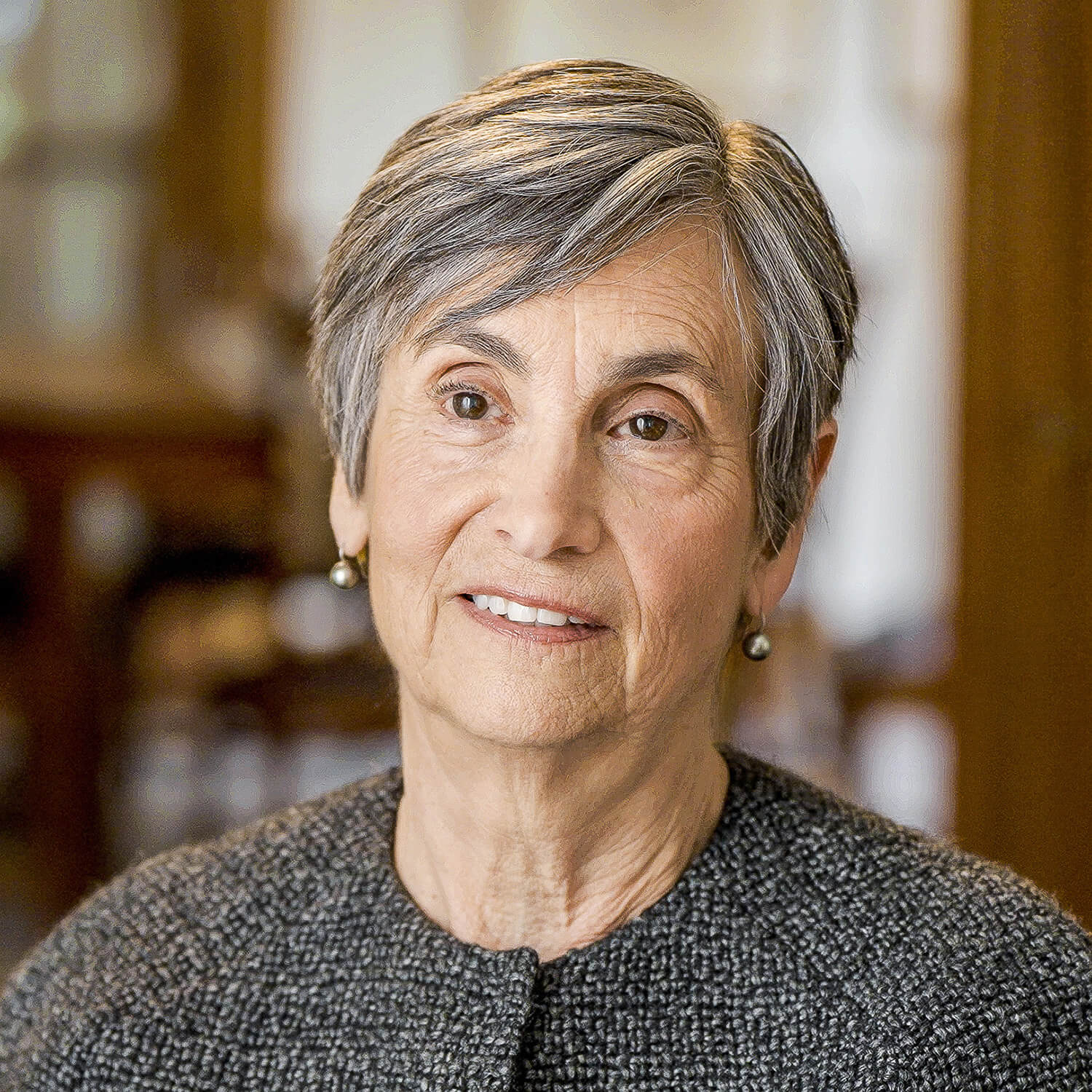
Answering A Need
Jane P. Jamieson ’75 knew the importance of maintaining Lehigh’s outdoor sculpture collection, but when she saw before-and-after photos of a sculpture, it underscored the need. “Untitled,” a steel sculpture by John Hock on the Goodman Campus, had become weathered and marked with graffiti. After restoration, it was once again a vivid pink.
“The sculpture looks completely different,” Jamieson recalls. “It was incredibly dramatic. By restoring sculptures, we’re taking them back to the artist’s original conception of what it’s supposed to be.”
Her favorites among the outdoor sculptures include “Trees” on the Goodman Campus. “I think the setting is incredible for something that is meant to depict a landscape,” she says.
Jamieson is pleased that others have joined her in supporting the Outdoor Sculpture Maintenance Endowment Fund. “I like the idea of collective support,” she says. “There really was a need to do this. I’m glad others have seen the value.”
A member of the first class of women admitted to Lehigh, Jamieson says her affinity for art dates to her high school days in Providence, Rhode Island, where she took art classes. “It’s always been an interest of mine,” she says. She continued studying fine arts at Lehigh. Becoming a member of the LUAG Director’s Advisory Council seems a natural outgrowth of that interest.
Her affinity for supporting Lehigh as a volunteer also has remained a priority. She was a member of the Lehigh Board of Trustees from 2002–19, including serving as vice chair for five years. In addition to serving two terms on the Executive Committee, she chaired the Public Affairs and the Nominations and Trusteeship committees and was a member of the Finance, Campus Planning and Operations, and Development committees. She co-chaired the Presidential Search Committee in 2014. She retired as executive vice president, marketing, for Fidelity Investments and lives in Waban, Massachusetts.
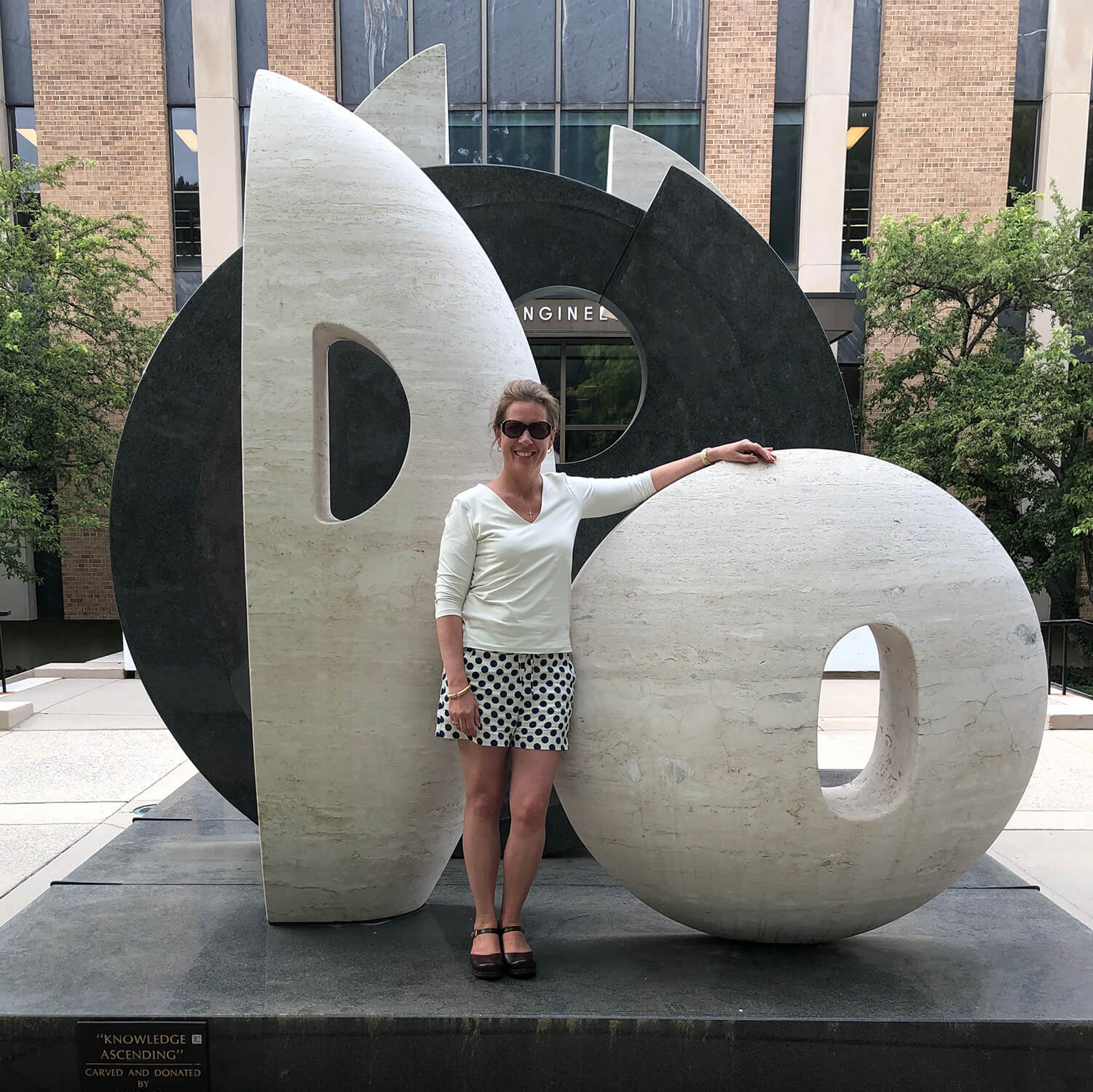
A Personal Connection
When Robin Cranage Lapoint ’91 ’96G sees the marble sculpture “Knowledge Ascending” on Lehigh’s campus, it’s like seeing a member of the family. Maybe that’s because her great uncle, Jay Dugan, sculpted it, donating it to Lehigh to honor his friend Lee Iacocca ’45 ’17GP ’69H. The black-and-white abstract sculpture graces Iacocca Plaza outside the E.W. Fairchild-Martindale Library and Computing Center. Lapoint explains that it was much more than the personal connection that drew her to support the Outdoor Sculpture Maintenance Endowment Fund. She’s seen firsthand the importance of maintaining a campus’s most valuable physical assets.
After graduating from Lehigh with majors in international careers and international relations, she worked for a consulting company specializing in not-for-profit asset management — including for colleges and universities — managing their physical assets, capital projects, and energy needs. “For three years (in that role), I was challenged by the problem of higher education not always funding deferred maintenance,” she says. She notes that has changed significantly since the ’90s, thanks to efforts like LUAG’s maintenance fund.
Her interest in supporting LUAG’s work was kindled after she attended a museum event for Boston-area alumni where she met Crow. “I've always loved art, from doing it to going to see it and traveling the world enjoying it,” Lapoint says. Shortly after their meeting, she joined the LUAG Director’s Advisory Council.
Lapoint and her husband, Alan Lapoint ’91, live in Freepoint, Maine. She is executive vice president of their business, The Strainrite Companies, a manufacturer of liquid filtration systems. Together they co-own three craft breweries. One of them, Geary Brewing Co., was one of the first 13 craft breweries licensed in the United States post Prohibition. This fall, the Lapoints are looking forward to their daughter Christina entering Lehigh as a member of the Class of 2029.
